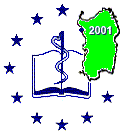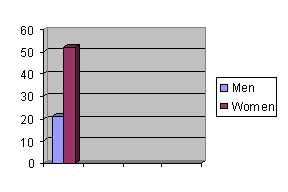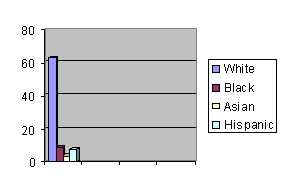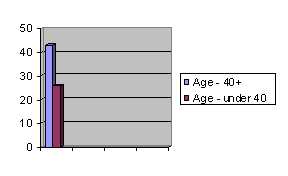 |
Librarians of the 21st Century.
How we view ourselves - Some images are better than others
Margaret Vugrin, M.S.L.S., AHIP and
Hershel Womack*, MS
|
|
|
Click here to see the poster in jpg format |
|
|
 |
Our profession frequently examines stereotypes of librarians as they are presented in the non-library media, i.e. television, movies, or magazines. We are very much interested in the visual portrayal of the "Librarian". Typically our professional dialog address the fact that we are often misrepresented. One area that has not been addressed however, is how we ourselves portray the "Librarian". This poster presentation will examine the visual portrayal of Librarians in professional library literature. How do we present ourselves, in our literature, in our journals, in our newsletters, in our marketing literature and other media? Six month's worth of library literature will be surveyed and reviewed. The images will be analyzed using basic photographic techniques. Not only will we examine the image we are presenting but we will also evaluate and suggest what we can do to give ourselves a 21st century look. Methods 115 professional library journals were identified that were available locally. 35 journals from this set were selected as they regularly printed photographs of librarians. All images of librarians for the last six months from these 35 professional journals were scanned with an Epson 1240 scanner with descreening filters (to lessen the difficulties of scanning half-toned images). [Halftone = images in newspapers or magazines composed of small dots of color or black and white to create entire image.] Recruitment packets from the American Libraries Association, the Special Libraries Association, the Medical Library Association and the Association of Law Librarians were requested and reviewed. Their websites were also evaluated. Very few librarian images were located either in print or on the web, from these professional sources. Two requests were sent to MEDLIB-L [listserve], one was sent at the end of October 2000, [October is National Librarian month in the US], while a second request was sent in Spring 2001. No responses were received from the first request and only two were received from the second request [The University of Pittsburgh, Department of Library and Information Science and from the National Library of Medicine]. Additional images from these sources were scanned and added to the image databank. Images were divided into four categories:
A total of 103 images were scanned and created the databank. Analysis of Databank: 49 or 47.5 % Snap Shots 28 or 28.7 % Mug Shots 18 or 17.4 % Traditional Portraits 08 or 7.7 % New Portraits Snapshots has three sub categories: Snapshot detail - usually
a headshot that has been cropped from a group image, and enlarged, usually
looses much detail, as it wasn't planned to be a large image. The image
has been enlarged with a loss of quality.
There were seven advertising pieces and these also fell into the snapshot category. Although created with lights and professional photographers they still held the "snapshot" look. Findings:
White 63, Black 9, Asian 4, Hispanic 8
Over 40 - 43, under 40 - 26 NOTE: The numbers do not add up to
103 as some images had both males and females, multiple ethnicity or were
group shots or the category did not apply.
Almost 50 % of the images that were located and published in professional journals were of the snapshot variety. Those are images that are commonly made with point and shoot cameras. 28% were also listed as "mug" shots. Together these two categories make up 78% of the images. Visually these are weak groups, however most of the images fall into these two categories. 17% are traditional portraits that tend to be boring even when well done because they are repetitive in nature. Therefore 95% of the images do very little to enhance the image of the librarian on par with other professionals i.e. physicians, lawyers etc. Librarians themselves are encouraging the stereotype held of our profession. The profession of librarian has changed
greatly from keeper of the books to information specialist. The changes
in our profession need to be projected visually to our public and using
professional quality images whenever we represent ourselves or our libraries,
in journals, newspapers or in-house public relations brochures will assist
this process. Maintain a current visual resume i.e. a professional portrait,
which typically can be good for four years. If librarians present themselves
as they wish to be perceived then the librarian stereotype will change
to portray them as the contemporary information specialists they are!
Suggestions for Creating Better Photographs
This will determine the type of camera lens that is needed. Different lens will achieve different results. Visual impact is heightened when the image is clean and direct. Don't always use the typical ten feet, straight on and flash photograph. Move around, change your position, change the angle, stoop, squat, stand on a ladder do whatever that will give you a fresh angle on the subject. As with nos. 2 and 3 this will make your impact stronger. If you are not able to crop with the camera, talk with your printers and crop during layout and design. Professionals in the medical field frequently refer to other professionals with greater expertise. This is also important when trying to project oneself visually. Hire professional photographers, the other professionals with whom you are competing, do. Professional photographers will be able to quickly and easily market you, your institution and profession. A current visual resume i.e. professional portrait, which is readily available when needed will greatly enhance the librarian image. A good portrait can be used for approximately four years unless there are some major physical changes. Having a professional portrait will preclude some of the reasons to use a point and shoot camera for professional needs. The "New Portraits" are visually effective because they project to the viewer additional information: personality, persona, and attitude in addition to a good likeness of the subject. |
|
|
|
|


